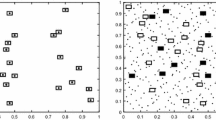Abstract
The paper deals with sampling from a finite population that is distributed over space and has a highly uneven spatial distribution. It suggests a sampling design that allocates a portion of the sample units that are well spread over the population and sequentially selects the remaining units in sub-areas that appear to be of more interest according to the study variable values observed during the survey. In order to estimate the population mean while using this sampling design, a computationally intense estimator, obtained via the Rao–Blackwell approach, is proposed and a resampling method is used that makes the inference computationally feasible. The whole sampling strategy is evaluated through several Monte Carlo experiments.
Similar content being viewed by others
References
Birnbaum ZW, Sirken MG (1965) Design of sample surveys to estimate the prevalence of rare diseases: three unbiased estimates, vital and health statistics, series 2, vol 6. Government Printing Office, Washington, DC
Brown JA, Salehi MM, Moradi M, Panahbehagh B, Smith DR (2012) Adaptive survey designs for sampling rare and clustered populations. Math Comput Simul. doi:10.1016/j.matcom.2012.09.008
Frank O, Snijders T (1994) Estimating the size of hidden populations using snowball sampling. J Off Stat 10:53–67
Grafström A, Lundström NLP, Schelin L (2012) Spatially balanced sampling through the pivotal method. Biometrics 68:514–520
Hastings WK (1970) Monte-Carlo sampling methods using MarKov chains and their applications. Biometrika 57:97–109
Robertson BL, Brown JA, McDonald T, Jaksons P (2013) BAS: balanced acceptance sampling of natural resources. Biometrics 3:776–784
Smith DR, Conroy MJ, Brakhage DH (1965) Efficiency of adaptive cluster sampling for estimating density of wintering waterfowl. Biometrics 51:777–788
Stevens DL Jr, Olsen AR (2004) Spatially balanced sampling of natural resources. J Am Stat Assoc 99:262–278
Thompson SK (2011) Adaptive network and spatial sampling. Surv Methodol 37:183–196
Thompson SK (2006) Adaptive web sampling. Biometrics 62:1224–1234
Thompson SK (1990) Adaptive cluster sampling. J Am Stat Assoc 85:1050–1059
Author information
Authors and Affiliations
Corresponding author
Additional information
Handling Editor: Bryan F. J. Manly.
Appendix
Appendix
Here are given the four populations with an uneven spatial distribution that are considered in the simulation study.
Rights and permissions
About this article
Cite this article
Rocco, E. Spatially-balanced adaptive web sampling. Environ Ecol Stat 23, 219–231 (2016). https://doi.org/10.1007/s10651-015-0336-5
Received:
Revised:
Published:
Issue Date:
DOI: https://doi.org/10.1007/s10651-015-0336-5








